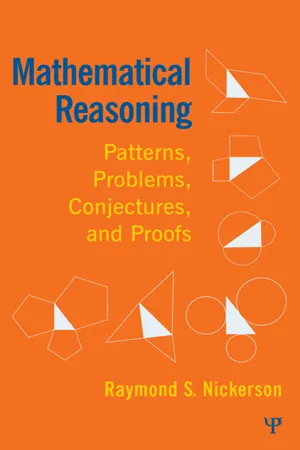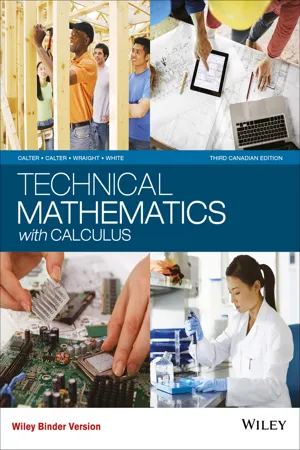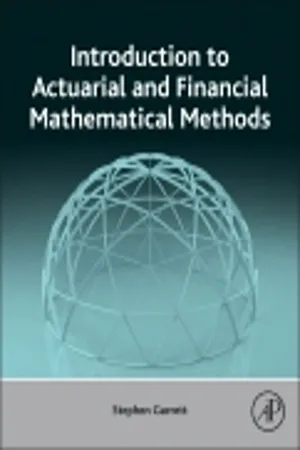Mathematics
Algebraic Notation
Algebraic notation is a system for representing mathematical expressions and equations using symbols and letters. It is commonly used in algebra to express relationships and operations in a concise and standardized way. In algebraic notation, variables are often used to represent unknown quantities, and operations are denoted by specific symbols such as +, -, *, and /.
Written by Perlego with AI-assistance
Related key terms
1 of 5
5 Key excerpts on "Algebraic Notation"
- eBook - ePub
Mathematical Reasoning
Patterns, Problems, Conjectures, and Proofs
- Raymond Nickerson(Author)
- 2011(Publication Date)
- Psychology Press(Publisher)
The answer would seem to lie in the habit of expecting mathematical abbreviations to retain some obvious link with what they were signifying and especially with the spoken word. The older Greek works, which inspired so much of the mathematics of the Renaissance period and after, were purely rhetorical. Mathematical ideas were explained in words; mathematical arguments were written in words. To adopt abbreviation of words is therefore a natural step; the change to abstract symbolism demands an intellectual leap of extraordinary magnitude. It is precisely this requirement to write and hence to think in terms of symbols which makes mathematics a difficult subject in the classroom today unless attention is paid to this particular intellectual demand. (p. 224)The invention of symbolic algebra represented a very significant step forward, not only for mathematics, but for the history of thought. An algebraic equation provides a means of packing a large amount of information into a few symbols. Jourdain (1913/1956) puts it this way: “By means of algebraic formulae, rules for the reconstruction of great numbers—sometimes an infinity—of facts of nature may be expressed very concisely or even embodied in a single expression. The essence of the formula is that it is an expression of a constant rule among variable quantities” (p. 38).The wide adoption of a standard notational scheme greatly facilitated communication among mathematicians and the building of any given mathematician on the work of others. A standard symbology was also a practical necessity for the printing of mathematical works, and the emergence of print technology was an impetus to the development of one.Algebraic Notation not only makes possible great economies of expression, but it also facilitates computation. Indeed, one may see the history of improvements in algebraic symbolism as a shifting of an ever-greater portion of the burden of computation and inference from the person to the symbolism. The symbolism encoded much of what its developers had learned about mathematical inference and preserved that knowledge so that it would not have to be rediscovered anew each time it was needed. Inferences that would be very difficult to make without the use of this, or some comparable, notation may become, with its use, matters of straightforward mechanical symbol manipulation.In many cases the need to make inferences was replaced with the ability to apply an algorithmic procedure. Dantzig (1930/2005) argues that the symbol is not a mere formality but rather the essence of algebra: “Replaced by a symbol the object becomes a complete abstraction, a mere operand - eBook - PDF
- Michael A. Calter, Paul A. Calter, Paul Wraight, Sarah White(Authors)
- 2016(Publication Date)
- Wiley(Publisher)
What is Algebra? Understanding the fundamental rules of algebra is important in order to calculate results for a wide variety of situations in science and technology. Algebra is a language of mathematics that is based on generalized arithmetic using letters to represent numbers in expressions, equations, or formulas. 2 ⋅ 2 ⋅ 2 ⋅ 2 = 2 4 translates to a ⋅ a ⋅ a ⋅ a = a 4 and more generally a a a a a a n n factors ( )( )( )( ) ( ) = The material in this chapter is the foundation on which other later chapters in this book are built, so your understanding of the concepts in this chapter is important. 2 ◆◆◆ OBJECTIVES ◆◆◆◆◆◆◆◆◆◆◆◆◆◆◆◆◆◆◆◆◆◆◆◆◆◆◆◆◆◆◆◆◆◆◆◆◆◆◆◆◆◆◆◆◆◆◆◆◆◆◆◆◆◆◆◆◆◆◆ When you have completed this chapter, you should be able to: • Identify and understand all the components (literal terms, constants, and variables) that make up algebra. • Add and subtract algebraic expressions and identify groups using symbols like parentheses and brackets. • Complete operations using integral exponents and remove groups of symbols in algebraic expressions. • Complete operations with algebraic expressions using multiplication. • Complete operations with algebraic expressions using division. Introduction to Algebra 2–1 Algebraic Expressions Mathematical Expressions A mathematical expression is a grouping of mathematical symbols, such as signs of operation, numbers, and letters. ◆◆◆ Example 1: The following are mathematical expressions: (a) x 2 - 2x + 3 (b) x 5 sin 3 ⋅ (c) + x e 5 log x 2 ◆◆◆ 41 Section 2–1 ◆ Algebraic Expressions Algebraic and Transcendental Expressions An algebraic expression is one containing algebraic symbols and operations (addition, subtrac- tion, multiplication, division, roots, and powers), such as in Example 1(a). A transcendental expression, such as in Examples 1(b) and (c), contains trigonometric, exponential, or logarith- mic functions. Equations None of the expressions in Example 1 contains an equal sign ( = ). - eBook - PDF
- Tom Bassarear, Meg Moss(Authors)
- 2019(Publication Date)
- Cengage Learning EMEA(Publisher)
285 6 SECTION 6.1 Understanding Patterns, Relations, and Functions SECTION 6.2 Representing and Analyzing Mathematical Situations and Structures Using Algebraic Symbols SECTION 6.3 Using Mathematical Models to Represent and Understand Quantitative Relationships SECTION 6.4 Analyzing Change in Various Contexts Algebraic Thinking Where in this book have you already been thinking algebraically? Some places were obvious, like when we used a variable, c, a, or some other letter to represent a number or amount of something. We also have been thinking algebraically in less obvious ways such as looking for patterns, see- ing relationships between the operations, and using models. Algebraic thinking begins in early elementary school when students consider a missing-addend approach like 3 5 1 5 . This way of thinking leads to solving algebraic equations like x 3 5 1 5 . Elementary students also look at pat- terns as a way to develop algebraic thinking. We will investigate this idea more fully in this chapter. Our Algebraic Notation developed over hundreds of years, and the driving force for inventing this notation was to make it easier to solve problems and communicate ideas. In the 1500s, the expression x 2 1 2x 2 8 would have been written as Zp 2Rm 8; R for an unknown, Z for zensus (an unknown squared), p for plus, and m for minus. Another major development in algebra was when René Descartes (1596–1650) invented the Cartesian coordinate system (named after him) to draw graphs on the x- and y-axes system. Legend has it that he got the idea from watching a fly crawl across a ceiling. He realized that a coordinate system could represent the fly’s location with one symbol—that is, the ordered pair. One of the most influential mathematicians that you likely have never heard of is Amalie Emmy Noether, who was born in Germany in 1882. Women were not allowed to take university courses, so she sat in on them simply to learn. - Stephen Garrett(Author)
- 2015(Publication Date)
- Academic Press(Publisher)
Chapter 1Mathematical Language
Abstract
In this chapter, we state and illustrate the use of common mathematical notation that will be used without further comment throughout this book. It is assumed that much of this section will have been familiar to you at some point of your education and is included as an aide-mémoire . Of course, given that the book will explore many areas of the application of mathematics, the material presented here may well prove to be incomplete. It should therefore be considered as an illustration of the level of mathematics that will be assumed as prerequisite, rather than a definitive list.Keywords Number systems Mathematical symbols Set notation Interval notation Quantifiers Equations Identities InequalitiesContents1.1 Common Mathematical Notation 31.1.1 Number systems 31.1.2 Mathematical symbols 61.2 More Advanced Notation 81.2.1 Set notation 81.2.2 Interval notation 121.2.3 Quantifiers and statements 131.3 Algebraic Expressions 141.3.1 Equations and identities 141.3.2 An introduction to mathematics on your computer 171.3.3 Inequalities 181.4 Questions 20Prerequisite knowledge Learning objectives • “School” mathematics• use of a calculator• algebraic manipulation• analytical solution of simple polynomial expressions• Familiarity with basic use of Excel• Define, recognize, and use• number systems• mathematical notation including set notation• bracket notation• quantifiers• equations, identities, and inequalitiesIn this chapter, we state and illustrate the use of common mathematical notation that will be used without further comment throughout this book. It is assumed that much of this section will have been familiar to you at some point of your education and is included as an aide-mémoire- eBook - PDF
- Donald Davis, William Armstrong, Mike McCraith, , Donald Davis, William Armstrong, Mike McCraith(Authors)
- 2018(Publication Date)
- Cengage Learning EMEA(Publisher)
55 r.nagy/Shutterstock.com Chapter 2 CHAPTER CONTENTS Section 2.1 Translating English to Algebra: Expressions, Equations, and Inequalities Section 2.2 Order of Operations and Evaluating Numerical Expressions Section 2.3 Basics of Solving Linear Equations Algebraic Expressions Used in Statistics and Basics of Solving Equations 56 CHAPTER 2 • Algebraic Expressions Used in Statistics and Basics of Solving Equations SECTION 2.1 Translating English to Algebra: Expressions, Equations, and Inequalities When most people think of arithmetic and algebra, what comes to mind is a page full of numbers and letters, with very few words or sentences associated with them. Statistics is a bit different. Many applications in statistics are based on situations that are presented in narrative form, with our task being to translate that narrative into mathematics. In this section, we learn how to translate English into algebra. OBJECTIVE 1 Differentiate between an Expression and an Equation What differentiates arithmetic from algebra is that algebra is the part of mathematics in which letters are used to represent numbers that are either unknown or change from time to time. These letters are known as variables . Commonly used variables include x , y , z , n , t , and so on. In statistics, some variables are denoted by lower case Greek letters such as m (pronounced “mu”), s (pronounced “sigma”), l (pronounced “lambda”), and x (pronounced “kai”). If we place a real number in front or behind a variable, we call that number a coefficient . For our purposes, many of the coefficients will be represented by rational numbers. Together, variables and coefficients make up algebraic terms . Terms that are separated with addition and subtraction signs are called algebraic expressions .
Index pages curate the most relevant extracts from our library of academic textbooks. They’ve been created using an in-house natural language model (NLM), each adding context and meaning to key research topics.




